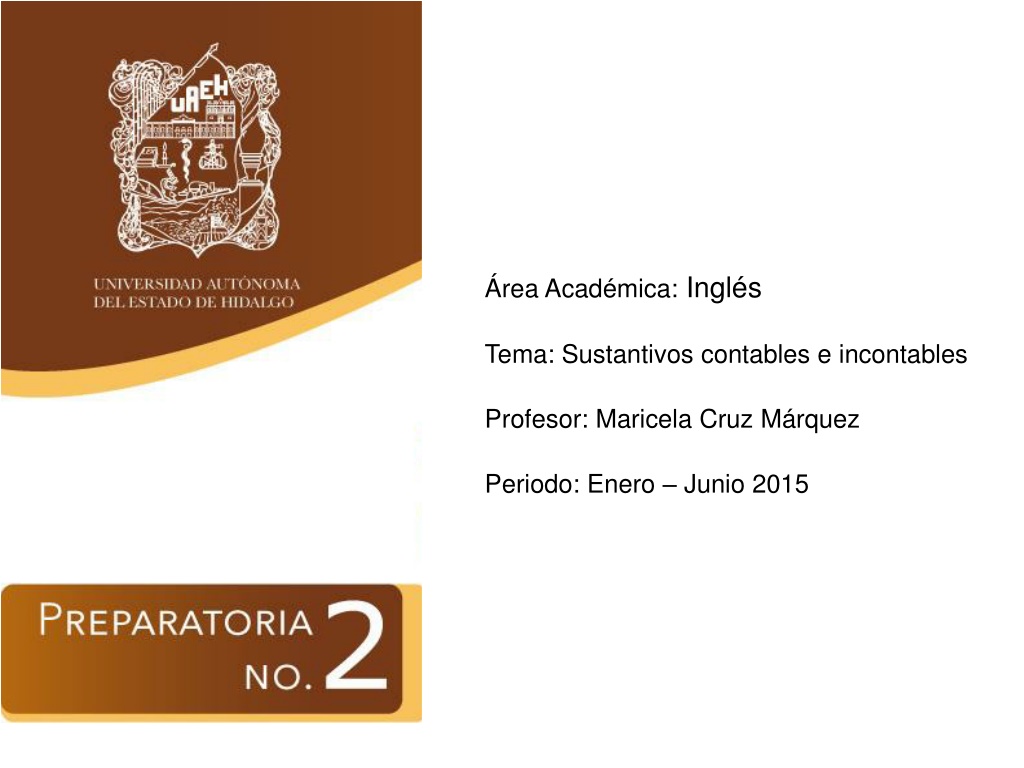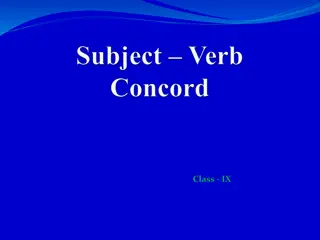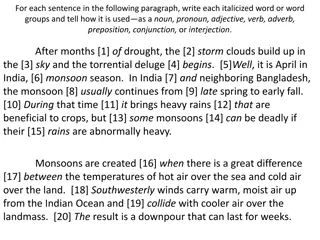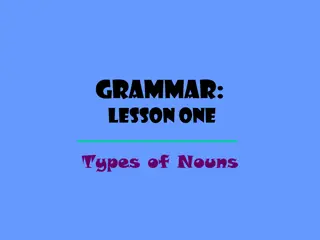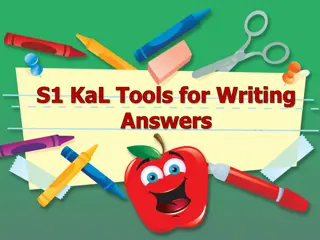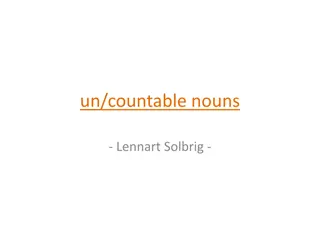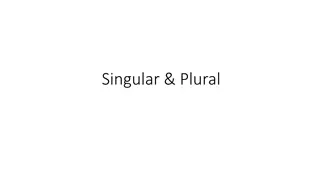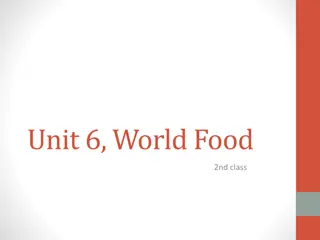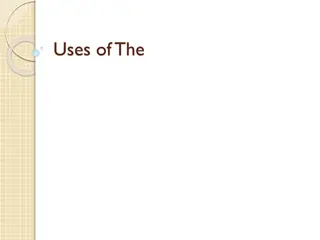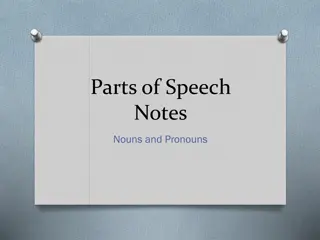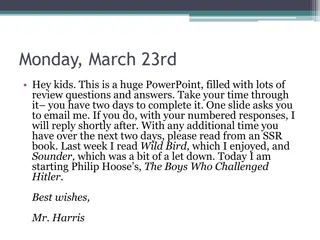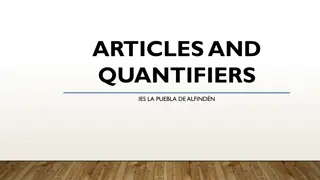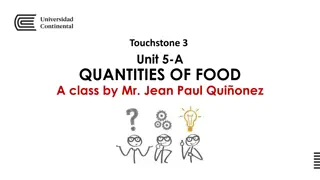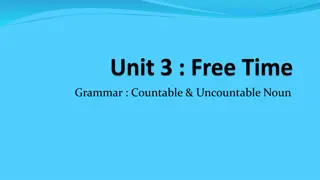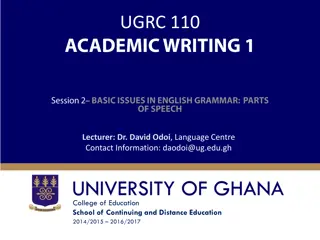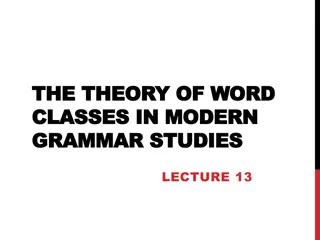Understanding Countable and Uncountable Nouns in English
This academic presentation by Professor Maricela Cruz Márquez explores countable and uncountable nouns in English, providing examples and explanations. Students learn to differentiate between the two types and practice using quantifiers to express quantity. The presentation also emphasizes communicating in a second language and specifying quantities in familiar contexts.
Download Presentation

Please find below an Image/Link to download the presentation.
The content on the website is provided AS IS for your information and personal use only. It may not be sold, licensed, or shared on other websites without obtaining consent from the author. Download presentation by click this link. If you encounter any issues during the download, it is possible that the publisher has removed the file from their server.
E N D
Presentation Transcript
rea Acadmica:Ingls Tema: Sustantivos contables e incontables Profesor: Maricela Cruz M rquez Periodo: Enero Junio 2015
Tema: Sustantivos contables e incontables Abstract: Student learns language through examples, real situations and inference of structure. They establish what they learn through grammatical exercises.
Tema: Sustantivos contables e incontables Keywords: countable, uncountable, some, any, a-an, how much, how many, a little, a few, much, many, a lot of, lots of.
Presentation Competencia gen rica: Escucha, interpreta y emite mensajes pertinentes en distintos contextos mediante la utilizaci n de medios, c digos y herramientas apropiados. Atributos: Se comunica en una segunda lengua en situaciones cotidianas. Competencia disciplinar extendida: Especificar cantidades en contornos familiares e inmediatos.
Objective: Students identify the use and the difference of countable and uncountable nouns, they also assume the use and structure of several quantifiers, besides they practice learning through several exercises.
COUNTABLE AND UNCOUNTABLE NOUNS Countable nouns are nouns which we can count. They have singular and plural forms. EXAMPLES: ONE ORANGE TWO ORANGES THREE ORANGES ETC.
COUNTABLE AND UNCOUNTABLE NOUNS Uncountable nouns are nouns which we cannot count. Uncountable nouns have only singular forms. These nouns include:
Uncountable nouns FOOD: cheese, butter, salt, pepper, bread, spaghetti, etc. LIQUID: coffee, milk, water, tea, lemonade, etc.
We can use the following nouns in front of some uncountable nouns to show quantity. A bottle A glass A carton A cup A bowl A packet A slice A loaf A kilo A bottle of lemonade A glass of water A carton of milk A cup of coffee A bowl of soup A packet of spaghetti A slice of bread A loaf of bread A kilo of cheese
We use some in the affirmative with countable nouns in the plural, and with uncountable nouns. EXAMPLES: I WANT SOME APPLES I WANT SOME CHEESE
We use any in the negative and the interrogative with both countable nouns, in the plural and uncountable nouns. EXAMPLES: Are there any bananas in the fridge? There isn t any ketchup at home.
We use a / an in all forms ( affirmative, negative, and interrogative) with countable nouns in the singular. EXAMPLES: There is a cat in the garage. There isn t a dog in the street. Is there a goldfish in the aquarium?
We use how much with uncountable nouns to ask about the amount of something. E.g. How much butter do we need? We use how many with countable nouns to ask about the number of things. E.g. How many pupils are there in your class?
When do we use a little and when a few? a little: non countable nouns milk, marmalade, money, time etc. a few: countable nouns bottles of milk, jars of marmalade, dollars, minutes etc. Examples: He has a little money left. He has a few dollars left.
When do we use much and many? We use much with singular uncountable nouns and many with plural nouns: Examples: I haven t got much energy today. Are there many trees your house?
Affirmatives: In affirmative clauses we sometimes use much and many in more formal styles. There is much concern about drug addiction in the US. He had watched many horror movies at home. In informal styles, we prefer to use lots of or a lot of: I went shopping and spent a lot of money Not: I went shopping and spent much money
Examples: We ve got lots of thing to do. That s a lot of money. There werent s a lot of choices. Can you hurry up? I don t have a lot of time. Are there a lot of good players at your tennis club? Have you eaten lots of chocolate?
How much, how many, few or little a lot of? ________water do you drink everyday? ________ brothers and sisters do you have? There are ________ students in the class today. I have _________ milk in the refrigerator. I need __________ apples to make the cake. Excuse me, __________ does that jacket cbost? A have __________, but __________ friends. My sister has ___________ friends.
Referencias: Maricela Cruz M rquez Double Click 1 workbook and grammar book Virginia Evans Neil O Sullivan Express Publishing, 2005
